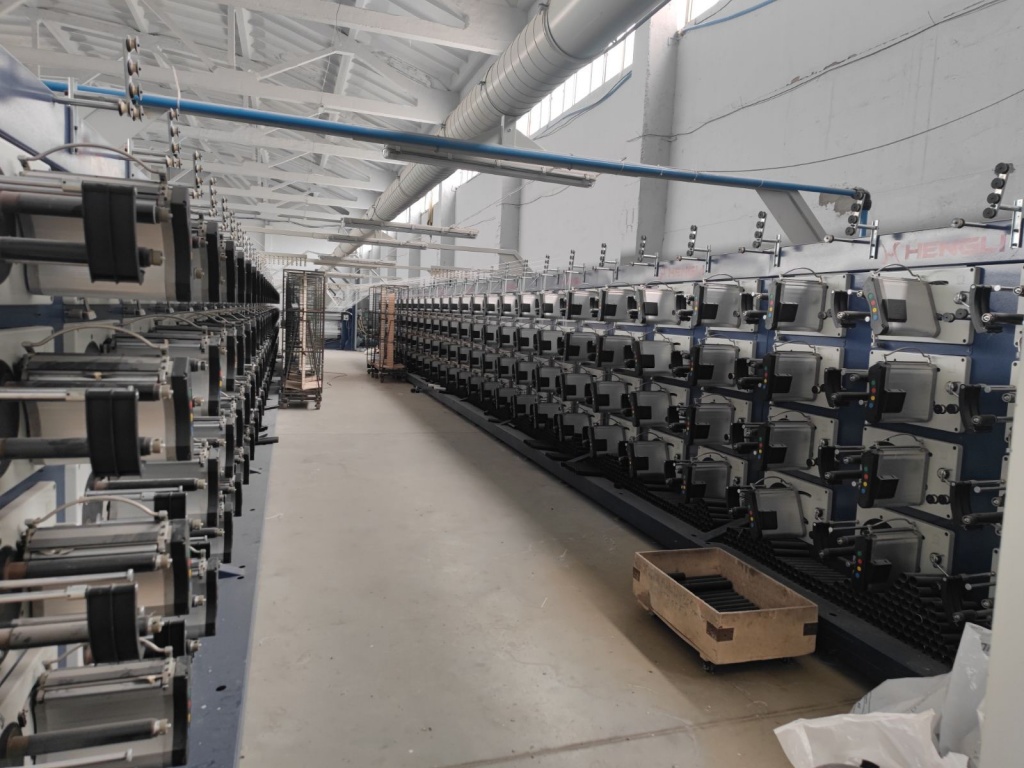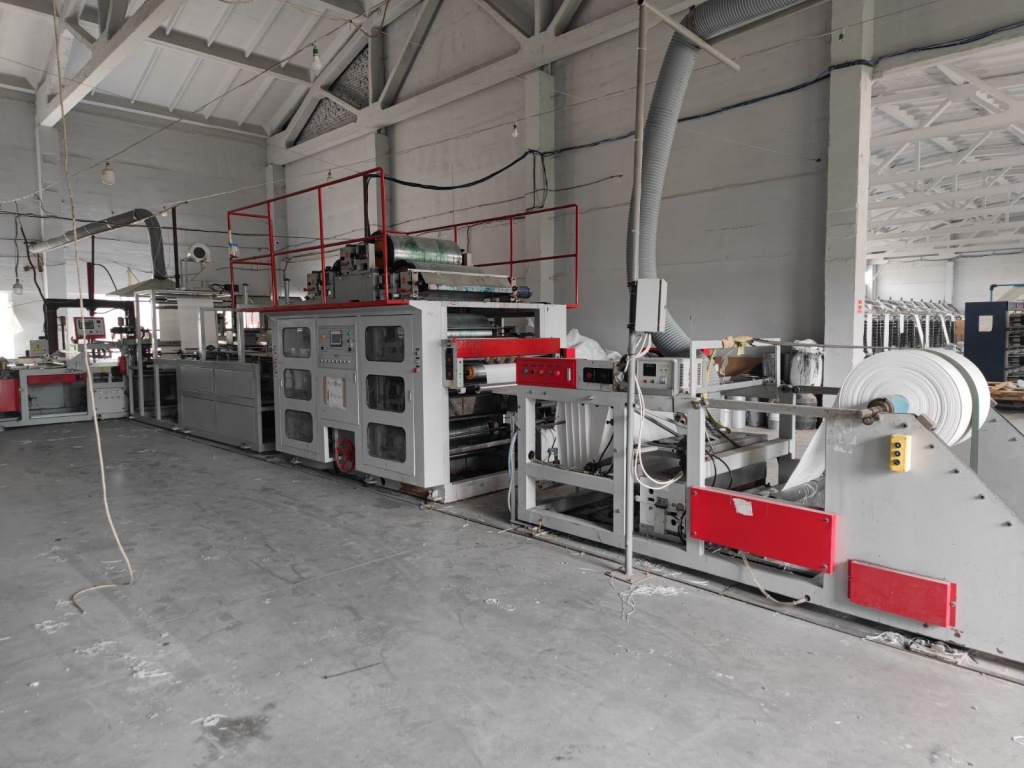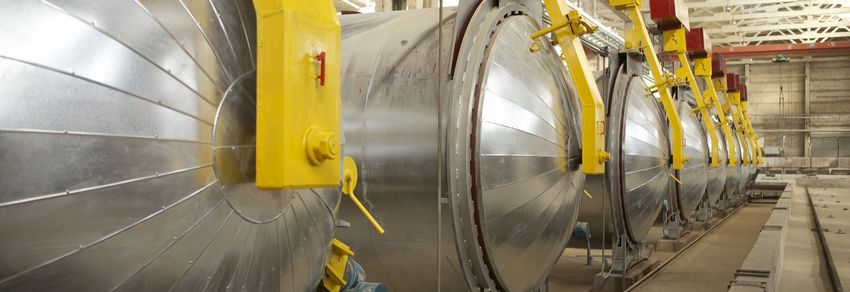!!!COMPANY "JUPITER" SELLS A TECHNOLOGICAL LINE FOR THE PRODUCTION OF POLYPROPYLENE BAGS!!! (MORE PHOTOS IN THE NEWS)
Process line:
Automatic winding heads - 216 pcs.
• Speed - 500m/min.
• Extruder capacity (depending on thread density) – up to 450 kg/h
• Screw diameter – 105 mm.
• Web width - 1200mm.
• Coefficient. Stretching - 4-8
Six-shuttle circular looms - 20 pcs.
• Sleeve width - up to 750 mm.
• Productivity (depending on thread density) – 300m/h.
Cutting and painting plant
• Productivity - 30m/min
• Bilateral
• Equipped with coronator and static removal device.
• Painting - 5 colors, double-sided (3 colors on one side, 2 on the other)
Industrial sewing machine - 5 pcs.




Aerated concrete is an artificial stone with spherical pores of 1-3 mm in diameter, which are uniformly distributed throughout the volume. The quality of aerated concrete is determined by the uniformity of pores’ distribution, the equality of their volumes and the closeness of pores. Concretes with a cellular structure are produced by the method of gassing on the basis of Portland cement and lime, and are called aerated concretes or gas silicates.
Aerated concrete (or autoclaved cellular concrete) consists of quartz sand, cement, quicklime and water. The most important technological feature of obtaining high-quality aerated concrete products is the creation of optimal conditions for two simultaneous processes of gas evolution and gas retention. During the production process, there is made a correspondence between gas evolution reaction rate and the rate of structural viscosity increase in the cement slurry. The flow of the gassing process is determined by a large number of different factors. The greatest influence on the speed of this process is exerted by the quantity and property of the gassing agent, the alkalinity, ambient temperature, and so on.
Raw materials for aerated concrete.
Such raw materials are used in the manufacture of aerated concrete:
- quartz sand;
- quicklime;
- cement;
- gypsum;
- aluminum paste (imported);
- water.
Most of the raw materials are made in Ukraine. The laboratory of the plant conducts constant input control of raw materials for compliance with the imposed quality requirements.
Mixing unit.
All the necessary raw materials (slurry, cement, lime, aluminum powder) through the dosing chamber (where the exact amount of each raw material is metered) are poured into the mixer in a strictly defined order. Precision of dosing is ensured by the use of automated equipment of "Siemens AG" Company (Germany). There, in the mixing unit, an intensive mixing takes place and further goes subsequent moulding of the received mass. Thorough mixing of the mass ensures uniformity of the mixture and evenness of bloating.
Moulding and solid mass maturing
After mixing, the aerated concrete mass is poured into the mould. The filled moulds are transported to the chamber for maturing and pre-hardening. In the maturing chamber for a certain time and at air temperature of not lower than +35 °C, occur such processes as: bloating (growth of the filled mass due to gas evolution), setting (due to the reaction of binders), and hardening of aerated concrete.
Cutting of massifs.
Dried mass (massif) is released from the mould and transported to the aerated concrete cutting line. On the cutting line with the help of longitudinal and transverse cutting machines the massif is cut into blocks of the required size with an accuracy of 1 mm. Accuracy of the aerated concrete geometry is the point that determines its high operational properties:
- high labor productivity in setting;
- reduction of labor costs for masonry, finishing works, and smoothing of walls.
Massive discharge and loading on autoclave carts
After the cutting line, the massifs, using a special discharger machine, are installed on autoclave pallets. The horizontal arrangement of the massifs allows to preventing their sticking during autoclaving and ensures uniform treatment in the autoclave. The conveyor moves the autoclave pallets to the loading portal, where the autoclave pallets are installed on the trolleys using a loader crane.
Комплектование автоклавных тележек и загрузка в автоклав.
Группировка и загрузка тележек в автоклав выполняется при помощи трансбордера. Трансбордер (устройство для перемещения тележки с одного рельсового пути на другой) двигаясь перпендикулярно рельсовым путям автоклавов, перемещает тележки с автоклавными поддонами на необходимые рельсовые пути автоклавов. В автоклав загружается пять автоклавных тележек, на каждой из которых находится три автоклавных поддона с резаным камнем.
Autoclave treatment
In the autoclave, hardening and formation of calcium silicate hydrates take place under the effect of temperature of 190 °C (375 °F) and pressure of 12 bar within 12 hours. At the end of the autoclave cycle, the pressure gradually decreases to atmospheric one. The autoclave door is opened and the autoclave carts are pulled out, and then moved by the transferring crane to a separate discharge path.
Transfer of aerated concrete from autoclave trolleys to wooden pallets
After discharge from the autoclave and cooling, the aerated concrete enters the unloading portal. The unloading portal is a loader crane and a special canting lever, through which aerated concrete is transferred to wooden pallets, and the released autoclave pallets are fed to the loading portal via return autoclave pallets transporter.
The system for transportation, discharge, loading and unloading of aerated concrete blocks was designed and manufactured by WKB Systems (Germany).
Packing of aerated concrete
Conveyor moves aerated concrete on pallets to the packing line, where with the help of a palletizer the blocks are packaged into a stretch-hood film. Stretch-hood film is a modern packaging material that is used for products' fastening to the pallets, by sleeving it with a special palletizer and pulling it on top of the product.
Further, a monolithic construction (which is firmly tightened in all three planes) is created. When packing, stretch-hood film covers the entire pallet with blocks, and the film is put under the pallet, which provides complete protection against atmospheric condensation, and ensures the safety of the finished product during storage and transportation. Packaged products are labeled and sent to the warehouse of finished products. The blocks of cellular concrete are available in density from 300 to 600 kg/m3 and are intended for a variety of purposes (insulation, interior partitions, and external walls).
Quality control
At each stage of the technological process of aerated concrete manufacture, the TCD service (technical control department) carries out technical control over adherence of all norms and parameters of technical processes. The laboratory of the plant constantly conducts incoming inspection of the supplied raw materials as well as it makes a full range of laboratory tests of the finished products. Quality passport is provided for each lot of aerated concrete.
MANUFACTURE OF METAL STRUCTURES
The metalware production unit of JUPITER Company is equipped with modern metal-cutting, bending, welding, lifting equipment and consists of Mechanical and Welding Departments. Mechanical Department is provided with turning, milling, cutting, drilling, slotting and other metal-cutting machine tools. Welding Department is equipped with rolls with programmed numerical control, which allows to roll sheet metal up to 30 mm thick. Availability of a gas cutting machine with numeric control makes it possible to produce complex curved parts from sheet material with maximum dimensions of 3200 x 12000 mm and thickness of up to 100 mm. In addition to semiautomatic devices for welding in shielding gases, Welding Department has an automatic welding machine for submerged arc welding of metals with large thicknesses. The welding machine equipped with roller bearings makes it possible to produce shells up to 3500 mm in diameter and to 34,000 mm in length.
The equipment of the enterprise with modern sheet metal processing equipment allowed us to make autoclaves on our own (external diameter of 2920 mm, length 34000 mm), demountable molds for pouring of massifs (6250x1250x700 mm), autoclave pallets and carts, storage silos for cement, lime and gypsum (V = 200 m3), water fire tanks (V = 100 m3), carrying trusses for the roof, building beams and columns.
The abovementioned equipment allows the production of:
- silos for storage of loose materials (cement, lime, gypsum, flour);;
- shells with diameter of up to 3500 mm and metal thickness of up to 30 mm;
- containers of various shapes and sizes (tanks, cisterns, water towers);
- casting demountable moulds, autoclave pallets and carts used for aerated concrete production;
- building columns, supports, crane beams;
- metal trusses, connectors, girders, cross beams;
- double T-beams, poles, crossbars, framework structures;
- metal overpass for motor vehicles;
- searchlight towers and lightning conductors;
- fire stairs, platforms and fences for industrial buildings;
- and to conduct a complex curvilinear cutting of sheet metal up to 100 mm thick
The key to success in the manufacture of the above named metal structures is not only the professionalism of highly qualified specialists, but also the availability of the necessary special equipment.

